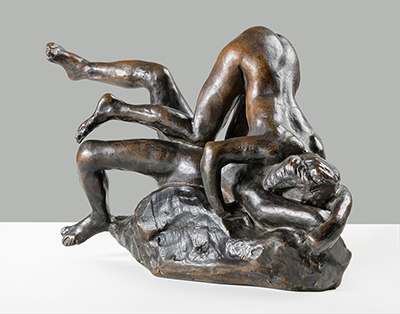Damned Women (Femmes Damnées), is one of Auguste Rodin's sculptures created between 1885 and 1890. It is a bronze cast with brown and green patina, which can now be seen in Museo Soumaya, Mexico City. The piece is part of Rodin's Gates of Hell project.
In a thirty-seven-year time frame Rodin worked on the project he continually altered, added or removed more than two hundred figures featured on the doors. As the counterpart to The Fallen Caryatid, the two women featured in Damned Women can be seen on the upper right of the sculpture. The Damned Women sculpture itself shows two females figures embracing, in a bravely erotic and passionate piece. With contorting bodies and projecting limbs, the sculpture is a manifestation of the act of physical pleasure and desire.
The disapproving title is taken from Charles Baudelaire's Flowers of Evil poem of the same name that depicts lesbians as 'damned women' that will be condemned to Hell for their unnatural yearnings. Rodin also explored this theme in Illusions Received by the Earth, Ovid's Metamorphoses and Youth Triumphant.
Auguste Rodin (1940-1917), was a prolific sculptor that was captivated with the human form, well known for creating figurative sculptures. Rodin is commonly thought of as the forbearer of modern sculpture. However, he did not set out to be rebellious against tradition. He took a craftsman-like approach to his pieces, he was schooled traditionally, and desired academic recognition. The artist is most renowned for his full length figures in larger-than-life sculptural portrayals, such as The Thinker, The Kiss, and The Three Shades. However he also experimented in everything from anatomical studies to historic busts.
In the 1880's Rodin's work had become progressively more erotic. Largely due to an obsession with two highly charged literary influences. These were Dante's Inferno, and Baudelaire's The Flowers of Evil. Rodin seems to be mostly influenced by Dante's epic poem and those who were 'damned by the sins of flesh.' Whereas Baudelaire’s poetry is notorious for its satanic nature. Rodin's later work featuring female figures are notable both for their freedom and spontaneity of craftsmanship, and for their sexually explicit nature.




